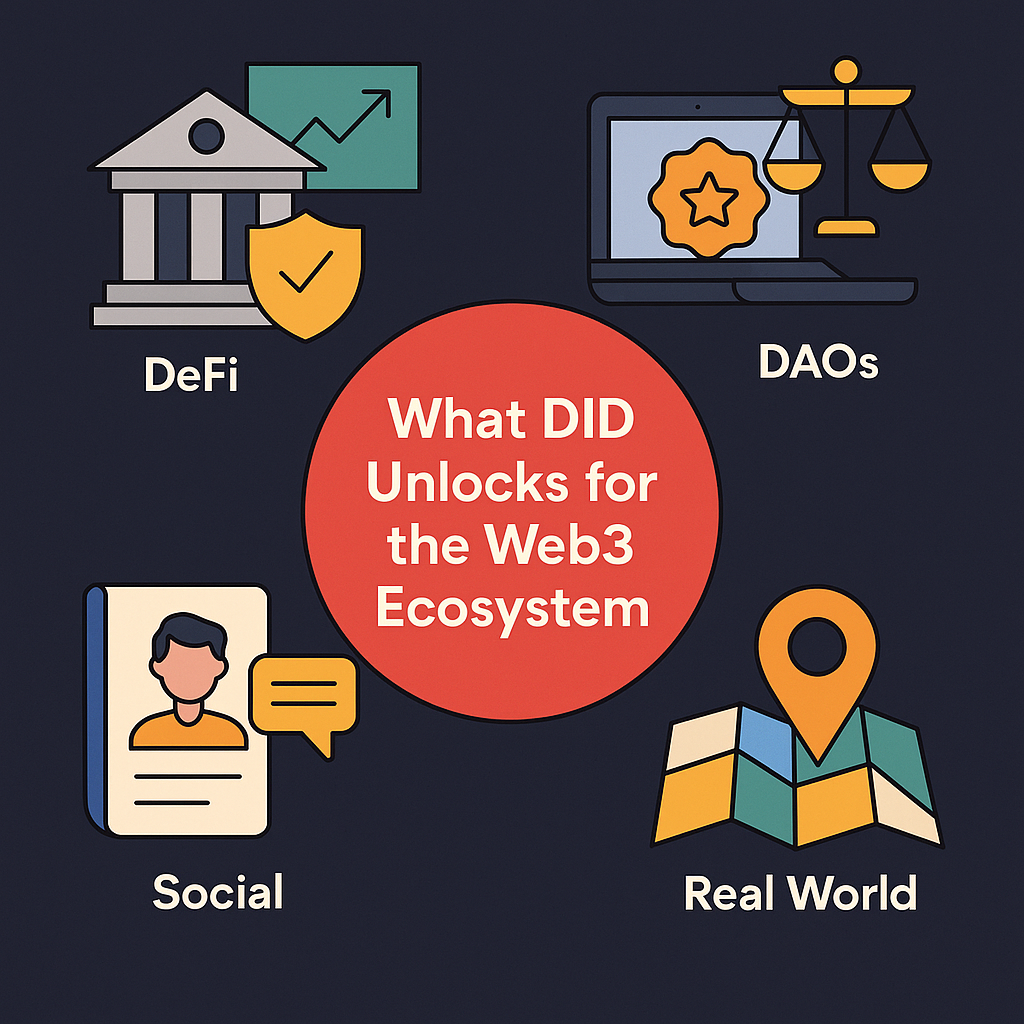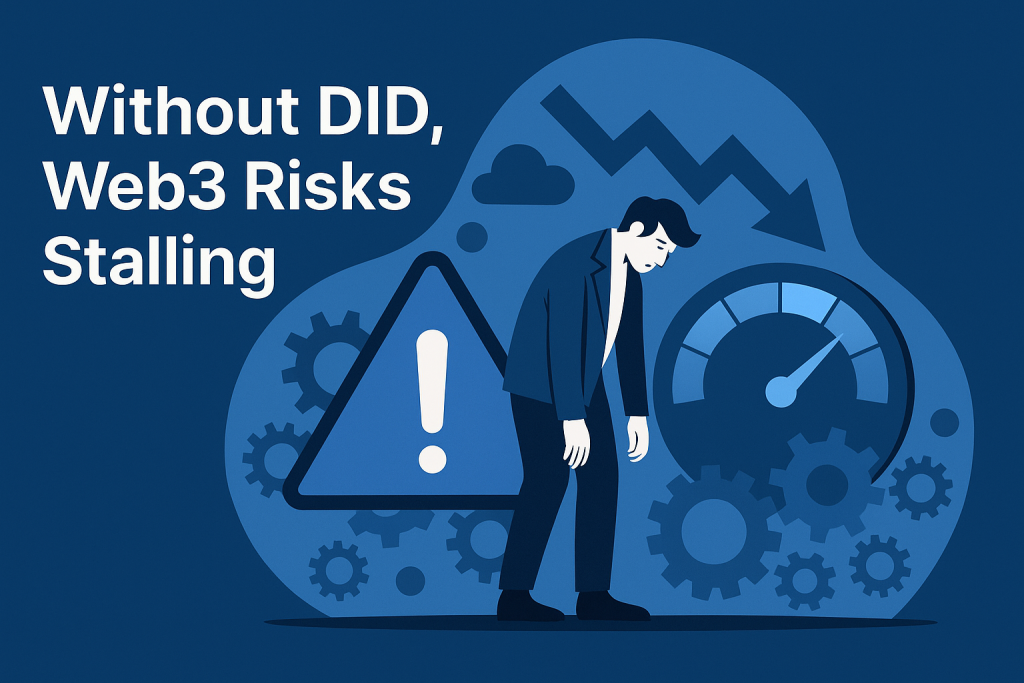Web3 has come a long way with billions in DeFi, millions of NFTs minted, and DAOs governing everything from protocols to pizza parties. But despite all the innovation, one major piece is still missing from the puzzle: identity.
Today, Decentralized Identity (DID) is emerging as a critical layer of Web3 infrastructure one that could finally unlock the next wave of mass adoption. While wallets, tokens, and smart contracts form the “what” of Web3, DID answers the “who” and that may be the key to making the decentralized internet truly usable, compliant, and trustworthy.
1. What Is Decentralized Identity (DID)?
Decentralized Identity (DID) is a digital identity model designed for Web3 where individuals own, control, and manage their identity independently, without relying on centralized platforms like Google, Facebook, or email-based logins.
Instead of usernames and passwords stored on corporate servers, Decentralized Identity leverages cryptographic proofs, verifiable credentials, and wallet-based attestations to create a secure, privacy-preserving identity layer that users fully control.
1.1. Core Principles of Decentralized Identity
A Decentralized Identity is:
-
Portable – You can carry it across the Web3 ecosystem. It’s not tied to any single app, platform, or chain. Your identity moves with you, just like your wallet.
-
Private – You decide what to share, with whom, and when. With selective disclosure and zero-knowledge proofs, Decentralized Identity lets you verify facts (like your age or membership) without exposing sensitive data.
-
Verifiable – Identities and credentials are cryptographically signed and tamper-proof. Third parties whether they’re dApps, DAOs, or lenders can trust your identity without relying on a central authority.
-
Composable – Your Decentralized Identity can integrate across multiple apps, blockchains, and use cases from DeFi and DAOs to Web3 social and beyond.
1.2. A Web3-Native Passport
Think of Decentralized Identity as your Web3-native passport:
It carries your credentials, your reputation, and your verifiable data and you control it all. Whether you’re accessing a DAO, applying for a loan, verifying your work history, or simply logging into a dApp, DID allows you to bring your identity with you, on your terms.
In a fragmented digital world, Decentralized Identity unifies your presence, enabling secure, trust-based interactions without giving up ownership or privacy.
2. Why Identity Is the Missing Layer in Web3
Web3 has made it possible to own your assets, data, and digital interactions a major leap from the platform-dominated world of Web2. But despite this innovation, one crucial piece is still missing: identity.

2.1. In Web2: Identity Is Centralized and Platform-Dependent
In the world of Web2, your identity is not truly yours it’s tightly tied to the platforms you use. Whether you log in with Google, Apple, Facebook, or an email address, your identity is created, stored, and managed by centralized corporations.
These platforms control everything about your digital self your personal data, preferences, browsing history, and behavior patterns. And more importantly, they monetize that information without giving you ownership or control.
Your digital identity is effectively rented. It’s locked behind each company’s infrastructure and cannot move with you across apps or services.
In this model, the user is the product. And when you leave a platform, your digital identity doesn’t come with you it stays behind, fragmented and owned by someone else.
That’s where Decentralized Identity stands in contrast. While Web2 identities are platform-bound and profit-driven, Decentralized Identity gives users the ability to own, control, and port their identity across the internet without relying on a central authority.
2.2. In Web3: You Own Assets, Not Identity
Web3 flips the Web2 model by giving users direct ownership of their digital assets. With a crypto wallet like MetaMask, Phantom, or Ledger, you control your tokens, NFTs, and interactions with decentralized applications (dApps) all without asking for permission. In Web3, you own your value.
But there’s a missing layer: identity.
While your wallet gives you access, it doesn’t say who you are. It’s just an alphanumeric address anonymous, pseudonymous, and lacking any meaningful context. It carries no history, no reputation, no relationships.
This default anonymity is powerful for privacy, but it also creates serious limitations for trust, access, and personalization. Without identity, every wallet looks the same whether it belongs to a developer, a scammer, a long-time DAO contributor, or a first-time user.
That’s where Decentralized Identity comes in.
A proper Decentralized Identity framework would let you:
-
Prove who you are (without revealing everything),
-
Show your on-chain reputation across ecosystems,
-
Carry verified credentials (KYC, achievements, social proof),
-
And build a consistent, portable digital persona that you actually control.
Without Decentralized Identity, Web3 users are stuck with ownership but without recognition.
And in a trustless world, some form of verifiable identity is what makes deeper coordination and connection possible.
2.3. What You Can’t Do Without Identity in Web3
Web3 may give users control over assets, but without a verifiable, portable Decentralized Identity, it remains limited in how users interact, build trust, and unlock deeper functionality. Below are key limitations that arise when identity is missing from the decentralized experience:
No Reputation Tracking
Without Decentralized Identity, there’s no consistent way to prove who you are or what you’ve contributed on-chain. Whether you’ve helped build a DAO, completed bounties, participated in governance, or curated communities there’s no unified profile that reflects that history.
Every dApp sees your wallet as a blank slate.
No reputation carries over because there’s no decentralized identity layer to anchor your behavior or build a cross-platform trust profile.
With Decentralized Identity, users could maintain an on-chain reputation that evolves with their contributions enabling recognition, trust, and new opportunities across Web3.
No Access to Undercollateralized Credit
Decentralized finance (DeFi) has unlocked new ways to borrow and lend but most of it remains overcollateralized, favoring users with substantial crypto holdings. This leaves out a massive segment of users who may be trustworthy but lack capital.
Without a Decentralized Identity system to verify someone’s credibility, income, or borrowing history, there’s no way to build trust without collateral unlike in traditional finance, where identity plays a central role in credit systems.
A well-integrated Decentralized Identity would enable reputation-based lending, using verified credentials, social proof, or past behavior making DeFi more inclusive and human-centric.
No Profile Portability
In the current Web3 environment, your identity is fragmented. You might have a strong presence on Lens Protocol, meaningful participation in Farcaster, and voting rights in a DAO but none of that is connected.
Without Decentralized Identity, you have no persistent profile. Each new dApp treats you like a brand-new user. Your social graph, activity, and community roles don’t travel with you.
With DID, users could bring their full Web3 identity including verifiable relationships, preferences, and activity wherever they go.
No Trusted Digital Persona
Building a recognizable, trustworthy digital persona across Web3 is nearly impossible without Decentralized Identity. Your interests, your contributions, even your governance participation are invisible to others unless you manually link them often at the cost of privacy.
This lack of identity makes it difficult to:
-
Join communities as a known contributor
-
Apply for on-chain jobs
-
Earn recognition or reputation
-
Build long-term credibility across platforms
A Decentralized Identity framework allows you to create a verifiable, pseudonymous persona that is respected, recognized, and portable without compromising control over your data.
2.4. Web3 Is Permissionless But Also Contextless
One of Web3’s most celebrated features is that it’s permissionless. Anyone, anywhere, can create a wallet and instantly interact with decentralized protocols no gatekeepers, no discrimination, no institutional barriers.
But while this openness is revolutionary, it comes with a hidden cost: a lack of context.
In Web3, every wallet address looks the same. A scammer, a seasoned builder, a core DAO contributor, or a new user all are reduced to pseudonymous strings of characters.
Without any form of Decentralized Identity, there’s no way to understand the person or entity behind the address.
This anonymity is valuable for privacy, but it also strips away critical layers that are essential for scaling Web3 beyond early adopters:
-
There’s no social layer to establish relationships or community trust.
-
No trust layer to signal experience, reputation, or credibility.
-
No compliance layer to meet regulatory or enterprise requirements without sacrificing decentralization.
Decentralized Identity changes that.
By providing a way to verify, preserve, and selectively share personal context, Decentralized Identity enables users to:
-
Prove their history, contributions, or roles without giving up privacy.
-
Build portable reputations that follow them across platforms.
-
Interact in Web3 spaces with trust and accountability, without reverting to centralized systems.
In short, Web3’s future depends on more than permissionless access.
It depends on context with sovereignty and Decentralized Identity is the foundation that will make that possible.
3. Core Components of DID
Here’s what makes DID work:
-
Wallet-based Authentication: Your crypto wallet whether on Ethereum, Solana, or another chain acts as your anchor of identity. Instead of relying on a username/password or third-party login, you authenticate using your private key, establishing ownership and access through self-custody. This shifts control of identity back to the user.
-
Verifiable Credentials (VCs): are digitally signed attestations issued by trusted entities like DAOs, applications, universities, or protocols. These can prove that:
-
You’ve completed KYC.
-
You’re a DAO contributor.
-
You earned a certificate or participated in a grant program.
These credentials can be selectively shared, allowing you to build a verifiable reputation while protecting sensitive data.
-
-
Zero-Knowledge Proofs: With Zero-Knowledge Proofs, you can prove facts without revealing personal information. For example, you can confirm that you’re over 18, a citizen of a specific country, or meet certain financial thresholds all without exposing the underlying data.
This makes Decentralized Identity both compliant and privacy-preserving, enabling trusted interactions without surveillance.
-
Open Standards : Standards such as W3C DIDs, EIP-4361 (Sign-In With Ethereum), and emerging Web3 protocols ensure that Decentralized Identity works across ecosystems.
This interoperability is crucial: your DID should function seamlessly between wallets, chains, and applications creating a unified, portable identity that’s recognized and respected everywhere in Web3.
4. What DID Unlocks for the Web3 Ecosystem
The value of Decentralized Identity (DID) goes far beyond simplifying logins. It introduces a powerful, trust-enhancing layer that brings structure, accountability, and scalability to the decentralized internet while keeping users in control.

Here’s what DID makes possible across key areas of Web3:
4.1. In DeFi: Trust Without Centralization
-
KYC/AML Compliance with Privacy
DID enables users to prove identity or jurisdiction without exposing personal data, using zero-knowledge proofs or verifiable credentials. -
Reputation-Based & Undercollateralized Lending
By linking lending behavior to a DID profile, users can build on-chain creditworthiness unlocking access to capital with less collateral. -
Sybil Resistance & Fraud Prevention
Unique, verifiable identities help protocols detect and prevent spam, bots, and multi-wallet manipulation without breaking decentralization.
4.2. In DAOs: Governance With Accountability
-
One-Person-One-Vote Systems
DID allows for pseudonymous but verifiable uniqueness, supporting voting models that resist Sybil attacks without compromising privacy. -
Contributor Reputation & Badges
Recognize and reward members based on verifiable contributions and history across DAOs not just token holdings. -
Transparent Yet Private Governance
Combine identity-based access and tracking with full control over what information is shared enabling pseudonymous governance with integrity.
4.3. In Web3 Social & NFTs: Real Digital Presence
-
Persistent Profiles Across Platforms
DID gives users a portable identity one they can carry from Lens Protocol to Farcaster, or from a DAO forum to a metaverse space. -
Attestation-Based Communities
Communities can form around shared, verifiable credentials such as “member of Gitcoin”, “ZK researcher”, or “early NFT creator”. -
Smarter Discovery and Recommendations
With user-consented metadata and interest graphs tied to a DID, platforms can offer personalized, privacy-respecting experiences.
4.4. In the Real World: Global Access to Services
-
Digital Credentials & Certificates
Education, employment, medical, or professional credentials can be issued as verifiable credentials linked to a DID accessible globally. -
Identity for the Unbanked or Stateless
Refugees, migrants, and unbanked individuals can use DID to establish recognized identity without relying on a national ID system. -
Seamless Cross-Border Onboarding
On-chain KYC and portable reputation make it easier for users to access services across jurisdictions, without repeated verification.
Decentralized Identity isn’t just infrastructure it’s an enabler. It transforms Web3 from a set of disconnected protocols into a coherent, user-centric network where trust scales, privacy is preserved, and opportunity is unlocked for everyone.
5. Without DID, Web3 Risks Stalling
As Web3 scales, it will inevitably collide with real-world complexities: regulatory scrutiny, rising fraud, fragmented user experiences, and the growing demand for personalization and trust.

But without a Decentralized Identity (DID) layer, the ecosystem remains fundamentally limited. It cannot offer:
-
Credit systems beyond overcollateralized lending
-
Compliance without sacrificing privacy
-
Continuity of identity across dApps, chains, and use cases
Instead of progressing, Web3 risks falling into one of two traps:
-
Staying a niche playground for crypto-native insiders, inaccessible to the masses.
-
Reverting to Web2-style identity models, where centralized platforms own and control your data once again.
Decentralized Identity offers a third path one that aligns with the core values of Web3:
-
Ownership – You control your identity, credentials, and how they’re used.
-
Privacy – Share only what’s necessary, thanks to selective disclosure and zero-knowledge proofs.
-
Portability – Carry your reputation and credentials across platforms and ecosystems.
-
Composability – Plug your identity into DeFi, DAOs, gaming, and beyond with no lock-in.
With DID, Web3 can evolve into a truly user-centric digital economy one that is open, trusted, and ready for global adoption.
Conclusion
If Web3 is about owning your assets, your data, and your digital presence then the next logical step is owning your identity.
Decentralized Identity (DID) isn’t just a technical layer. It’s the missing link between users and applications, between privacy and compliance, between pseudonymity and trust. It transforms how we interact, verify, and belong in the decentralized world.
As DID adoption grows, the question will shift from “Who owns your data?”
to “What can your identity unlock for you today?”
This is the future of a truly user-controlled internet where your identity isn’t rented from platforms, but carried by you, on your terms. Explore more insights on digital identity, Web3 innovation, and the evolving crypto landscape. Follow FMCPAY News for expert coverage, real-time updates, and the tools to help you thrive in the next era of the internet.


